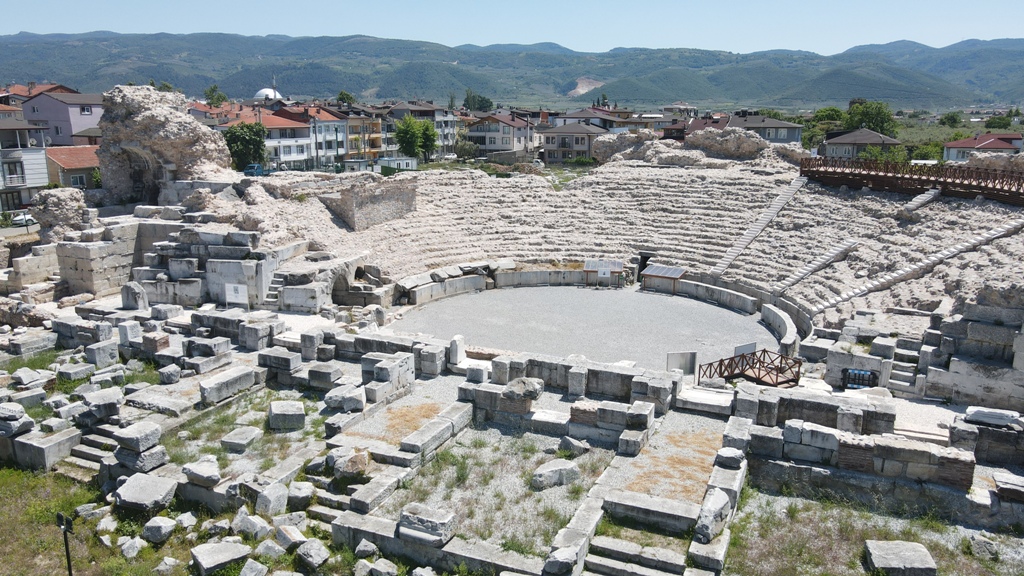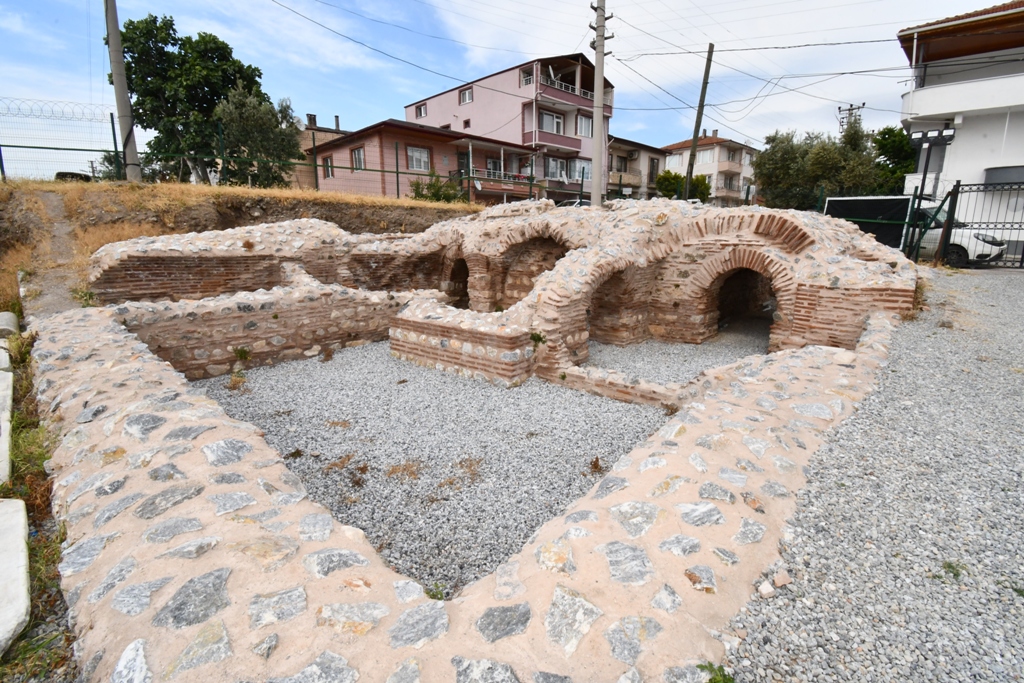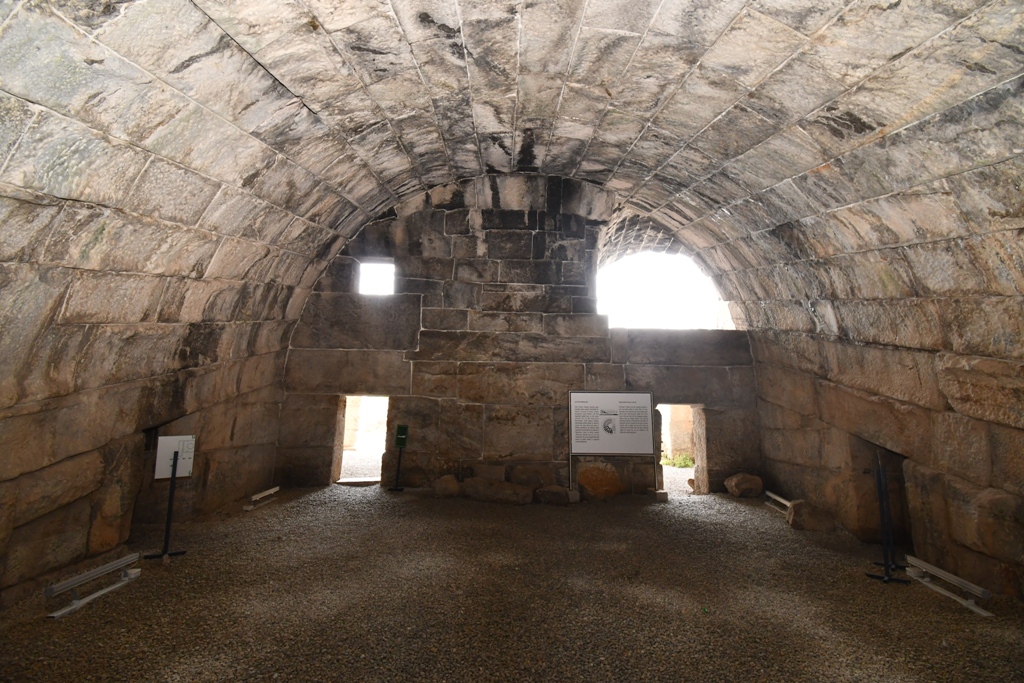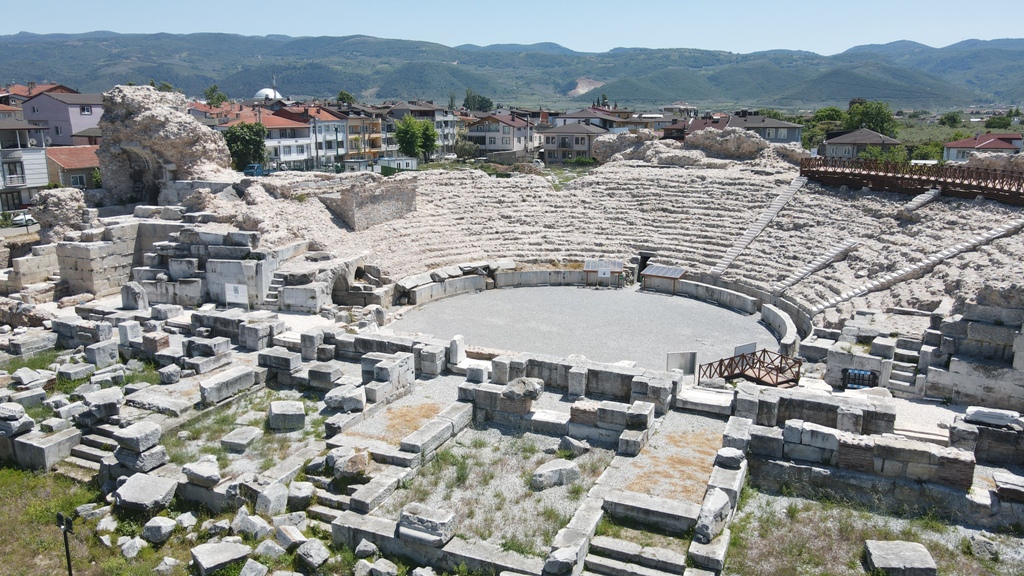Tiyatro, İmparator Traian Dönemi’nde (MS 98-117) inşa edilmiştir. İmparator ile Bithynia Valisi Plinius arasındaki mektuplaşmalardan tiyatronun MS 111 yılında henüz inşaat halinde olduğunu ve o zamana kadar 10 milyon sesterces (yaklaşık 5 milyon USD) para harcandığı bilinmektedir. 10.000 kişilik olan tiyatro, 102 x 79 m boyutlarındadır. Düz bir alana tonozlu bir altyapı ile üç katlı olarak yapılmış olmasıyla Anadolu’daki tek örnektir. Roma betonu kullanılarak inşa edilen yapının sahne binasında ve analemma duvarlarında mermer bloklar dikkati çeker. İznik Roma Tiyatrosu’nun orkhestrası, Roma tiyatrolarının aksine Helenistik karakteri sürdürürcesine, yarım daireden biraz fazla, yani at nalı planlıdır.
Yarım daireyi aşan caveada, gösterilerle seyirciler arasına mesafe koymak amacıyla alt cavea yüksek bir duvar (konistra) yapılarak orkhestra zemininden ayrılmıştır. Tiyatro, alt caveayı taşıyan yedi adet trapezoidal (yamuk) tonozun devamında yükseltilmiş ikili 10 beşik tonoz ile toplam 24 metre yüksekliğinde olmalıydı. Günümüze yalnızca alt yapısı korunan 54x13 m boyutlarındaki sahne binasının, en az iki katlı olduğu ve önünde geniş bir ön sahnenin yer aldığı düşünülmektedir.
Sahne binasının seyirciye bakan yüzünde beş adet, arkasında ise üç adet giriş bulunmaktadır. Bu odaların tiyatro oyunları sırasında depo veya dekor/kostüm değişimi için kullanıldığı bilinmektedir. Scaenae frons olarak adlandırılan cephede Korinth sütunlarıyla çevrelenmiş dört adet niş, sahnenin orta noktasına göre simetrik olarak yerleştirilmiştir. Tiyatronun özenli işçilikli, zengin süslemeli bir scaenae fronsa sahip olduğu, kazılarda ele geçen kapı sövesi parçaları üzerindeki sarmaşık motifleri ve akanthus yapraklarının arasında Herakles, Perseus, Pegasus ve Eros gibi mitolojik figürlerin işlendiği mimari plastik parçalardan anlaşılmaktadır.
Sahne binasının her iki tarafında, tiyatroya girişi anıtsallaştırmak ve bazı resepsiyonlar için kullanılan iki katlı sütunlu galeriler (basilicae theatrum) bulunuyordu. İmparator Hadrian Dönemi’nde yaptırıldığı anlaşılan sütunlu galeriler, 11x11 m boyutlarında ve her yönde dört sütunludur. Alt ve üst katta toplam 24 adet Korinth düzeninde sütun bulunur. Alt katta postamentler mevcut iken, üst katta parapetler arasında Hermaeler bulunmaktadır. Roma İmparatorluk sınırları içerisinde, sütunların arasında Hermaeli parapetlerin kullanıldığı başka iki katlı galeri örneği yoktur.
Tiyatroda, MS 2.-3. yüzyıllarda diğer oyunların yanı sıra özellikle dönemin modası olan gladyatör gösterileri yapılmıştır. Hıristiyanlığın resmi din olarak kabul edildiği MS 4. yüzyıldan sonra, orkhestra duvarlarındaki Hz. Meryem ve Hz. İsa freskleri, kutsal haç ve diğer Hıristiyanlık motiflerinden anlaşıldığı üzere tiyatro dini amaçlarla kullanılmıştır. Bu yüzden MS 11. ve 13. yüzyıllarda cavea üzerine ve tiyatronun güneydoğusuna iki adet Mezarlık Kilisesi inşa edilmiştir.
Bizans Dönemi'nde (9.-14. yüzyıl) ve İznik’in Çini üretim merkezi olduğu Osmanlı Dönemi'nde (14.-17. yüzyıl) kesintisiz üretim yapıldığı kazılar sırasında ortaya çıkan fırınlardan ve ele geçen buluntulardan anlaşılmaktadır. Osmanlı Dönemi’nde çini ve seramik üretim merkezi olan İznik’te, özellikle 16. yüzyılda çini sanatı zirveye ulaşmıştır. İznik Roma Tiyatrosu’nda da 11 adet fırın ateşhanesi, iki adet atölye ve üretimi kanıtlayan çok sayıda fırın malzemeleri ve yarı mamul parçalar ele geçmiştir. Tiyatroda genellikle kare formlu yapılan fırınların yanında yuvarlak formdaki fırınlar da bulunmaktadır. Fırınlar özellikle yağmur ve rüzgârdan korunaklı olan tiyatro tonozlarının içerisinde ve yakın çevresinde inşa edilmiştir. Tiyatroda çok sayıda fırın ele geçmesine rağmen fırınların yalnızca ateşhane bölümleri korunmuştur.
Genel olarak; Bizans Dönemi'ne tarihlenen baskı, slip, sgraffito, champleve gibi tekniklerle dekorlanmış seramiklere rastlanmıştır. Osmanlı Dönemi'nde ise; Milet işi, baskı, boyama, akıtma, slip, sgraffito gibi kırmızı hamurlu teknikler ile İznik’e asıl ününü kazandıran mavi-beyaz, Haliç, Şam ve Rodos işi olarak bilinen beyaz hamurlu teknikler hakimdir. Ayrıca seramik üretimi sırasında kullanılan üç ayak, semer, yastık, simit, raf, raf ayağı, makara gibi fırın destek malzemeleriyle de yoğun bir şekilde karşılaşılmıştır.
Tiyatronun cavea, orkhestra ve güneyindeki dolgu toprak içerisinde rastlanan iskeletler, tiyatro ve çevresinin mezarlık alanı olarak kullanıldığını göstermektedir. İskeletlerin büyük çoğunluğunun yetişkin erkeklere ait olması, özensiz gömülmesi ve savaş aletleriyle yapılmış yaralanmış olması nedeniyle, mezarların savaşta ölen askerlere ait olduğu düşünülmektedir. Özellikle tiyatro ve çevresindeki Nekropol alanının I. ve IV. Haçlı Seferleri (11.-13. yüzyıl) sırasında yoğun olarak kullanıldığı anlaşılmaktadır.
ROMAN THEATER at NICAEA
The theater was built during the reign of Trajan (AD 98-117). From the correspondence between the Emperor and Pliny, the Governor of Bithynia, the Theater was still under construction in AD 111 and that ten million sesterces (c. $US 5 million) had been spent by then. The 8,000-seat theater measures 102 x 79 m. It is the only example in Asia Minor as it was built on a flat area with a vaulted infrastructure and three floors. The building was constructed using Roman concrete and marble blocks stand out in the stage building and analemma walls. Unlike the Roman theaters, the orchestra of the Roman theater of Nicaea is slightly horseshoe-shaped as in Hellenistic period.
In the cavea exceeding the semicircle, the lower cavea was separated from the orchestra floor by a high conistra. The reason for this was to put distance between the performances in the orchestra and the audience. It is 24 m high in total with ten barrel vaults raised on the continuation of seven trapezoidal vaults carrying the lower cavea. The stage building whose foundations are preserved, is thought to have been two-stored in its original condition with a dimension of 54x13 m.
There are five entrances on the side facing the audience and three entrances behind the stage building. It is known that these rooms were used for storing or changing props/costumes during theater performances. That the theater had a richly decorated scaenae frons with elaborate workmanship is evident from the architectural fragments found during the excavations, including ivy motifs on the door jamb fragments and mythological figures such as Heracles, Perseus, Pegasus and Erotes among acanthus leaves. of the scaenae,
The colonnaded galleries, located both sides of the stage building to monumentalize the entrance of the theater. There are 11x11 m in size and have four Corinthian columns in each direction that built during the Hadrian era. There are total of 24 columns on the upper and lower floors. While postaments exist on the lower floor, there are Hermae between the parapets on the upper floor. There is no other example of a two-storey gallery using the sequence of column, parapet, Hermae within the entire Roman Empire.
In the 2nd-3rd centuries AD, especially gladiatorial games, which were the fashion of the period, were played in this theater. After the 4th century, when Christianity was adopted as the official religion, the theater was used for religious purposes, as evidenced by the frescoes of Virgin Mary and Chris Child on the orchestra walls, Holy Cross and other relics. In the 11th-13th centuries, two cemetery churches were built on the cavea and to the south-east of the theater.
There was continuous production from Byzantine (9th-14th century) to Ottoman Period (14th-17th century) depending on the furnaces and artifacts uncovered during the excavations. During the Ottoman period, many ceramic kilns were built in sheltered areas such as vaults. Nicaea was the center of tile and ceramic production during the Ottoman period, and the art of tile production reached its peak in the 16th century. In the theater of Nicaea, eleven kiln fireplaces, two workshops and many kiln materials and semi-product fragments were excavated. In the theater, there are generally square-shaped as well as round-shaped ovens. These ovens were especially positioned in the vicinity of the vaults, which were sheltered from rain and wind. Although many ovens were found in the theater, detailed information about the architecture and technology of the ashtray section of kilns could not be obtained since only the firebox section of the ovens were preserved.
In general; ceramics were found decorated with techniques such as impressed, painted, slip, sgraffito and champleve dating to the Byzantine Period. During the Ottoman Period; a lot of tiles and ceramics belonging to the red paste techniques such as Miletus, impressed, painted, splashed, slip, sgraffito and the blue-white techniques such as Golden Horn, Damascus and Rhodes wares that brought Iznik its real fame were found. In addition, tripods, saddles, pillows, bagels, shelves used for ceramic production and oven support materials such as shelf pods and pulleys were also encountered extensively.
The skeletons found in the cavea, orchestra and the fill soil to the south of the theater indicate that the theater and its surroundings were used as a cemetery. Since the majority of the skeletons are adult male, buried in a sloppy manner and have injuries inflicted by war tools, it is assumed that the graves belonged to soldiers who possibly died in the war. It is understood that the theater and the surrounding Necropolis area were used intensively during the 1st and 4th Crusades (11th–13th century).
FOTOĞRAF GALERİSİ TARİHİ YERLER
TARİHİ YERLER





